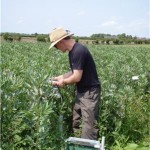X-rays help yields & pollution
Researchers at Lancaster University are using X-rays to help farmers increase yields and cut water pollution following an unexpected discovery in a pea and bean crop.
Plant and Soil Scientists hope to combine two new technologies to provide a rapid “same day” measurement of soil phosphorus availability, enabling farmers and growers to make more informed decisions about fertiliser application.
The move to develop this technique came about following an unexpected discovery by Dr Shane Rothwell, as part of his PhD studies at Lancaster University.
Dr Rothwell noticed that, contrary to expectations, pea and bean crop yields were sometimes decreased by up to 30 per cent when they were treated with recommended levels of lime – despite the fact that application of lime is expected to to improve the availability of plant nutrients.
He demonstrated that the reduced crop growth was associated with lower plant phosphorus content but existing ways of measuring the phosphorus in soil available for plant uptake were not picking up on the problem.
Consequently, developing a test to more accurately predict soil phosphorus availability following liming would benefit farmers and the environment, preventing waste and pollution.
The new method will combine two different technologies – the Diffusive Gradients in Thin Films (DGT) technique that was developed by Professor Hao Zhang at Lancaster, and portable x-ray fluorescence spectrometry (pXRF).
Phosphorus is an important plant nutrient. But there is widespread concern that repeated fertiliser applications to UK agricultural soils are causing phosphorus “leakage” to the environment due to drainage below the crop rootzone and surface runoff, which can pollute waterways and cause eutrophication of streams and rivers.
Lead scientist Professor Hao Zhang of Lancaster University said: “This research represents an exciting opportunity to develop new technologies that will make a real difference to how farmers manage phosphorus fertiliser applications to their crops.”
This new research – funded by Biotechnology and Biological Sciences Research Council (BBSRC) and Natural Environment Research Council’s (NERC) Sustainable Agriculture Research Innovation Club (SARIC) – aims to create an effective test to plug the gap.
Agronomist Dr Ian Dodd of Lancaster University said: “Current methods available to growers for establishing crop phosphorus availability and fertiliser application rates need to be brought up to date. By involving farmers in this research via UK wide field trials we can establish the potential for this technology in real world scenarios.
“We hope this work will lead to the development of a commercial service that will allow farmers to make better informed decisions enabling them to more precisely and sustainably manage phosphorus on their land.”
The work will be trialled at Myerscough College under a collaborative research arrangement between Myerscough and Lancaster.
The LEC research team includes Dr Shane Rothwell, Dr Ian Dodd, Dr Ben Surridge, Professor John Quinton and Professor Hao Zhang.
As part of the project, Lancaster researchers will also work with Dr Martin Blackwell, Rothamsted Research, to mine an existing data set that has measured phosphorus concentrations within drainage water from the North Wyke Farm Platform, to determine if the regular liming programme has mitigated phosphorus losses from the landscape.
Dr Rothwell’s work at Myerscough represents a return to his educational roots, as he first studied at Myerscough 20 years ago before returning for a Bachelor of Science (Arboriculture) in 2008.
Category: Environment

